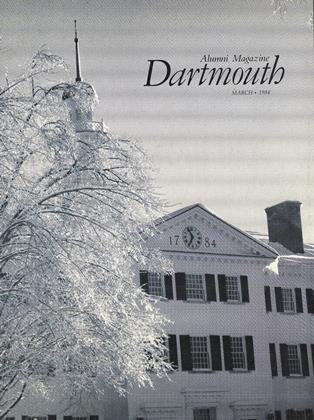NO PLACE TO HIDE, 1946/1984 by David Bradley '38. Foreword by Jerome B. Wiesner. University Press of New England, 1983. 217 pp., $18.00 cloth, $8.95 paperback.
The most extraordinary thing about this wise, lucid, and beautifully-written book is that it has been so long out of print. First published in 1948, it met with instant attention. But then attention flagged: as T. S. Eliot warned us, "humankind cannot bear very much reality." It is now republished with an even wiser, temperately-expressed, yet anguished, epilogue.
In 1948 David Bradley was a young medical officer assigned to monitor the Radiological Safety program at the Bikini Tests, "Operation Crossroads," an extraordinary naval laboratory of radiological hazard whose findings (together with those of Hiroshima and Nagasaki) still offer us some of the most sombre data ever collected.
What is remarkable is this book is not the scientific evidence preserved in a daily "log" (even today some of the monitoring is classified as secret), but the fact that the event found, in David Bradley, a chronicler with the compassion and command of language to match its historical significance. It is the log of a poet as much as of a medical man. Monitoring radioactivity on the rocks of Cherry, a small atoll ("even the great Pacific itself cannot wash out a roentgen of it"), Bradley had time to pause and cast a reflective eye over the whole scene:
The lagoon side of little Cherry has more to tell of the Bikini tests than incidental radioactivity. There the full story of man's coming is spread out on the beach: boxes, mattresses, life belts, tires, boots, bottles, broken-up landing craft, rusting machinery and oil drums, all the crud and corruption of civilization spread out over the sands, and smeared over with inches of tar and oil.
Bradley's observant eye had time to notice these things: time also to notice the comedy of all great military operations (the vast difference between the pomp and professions "for the record" and the haphazard exigencies of execution), as well as the tolerant comedy of human relations within a military structure in which most of the performers felt themselves to be misfits playing roles.
Yet if there were roles being played, there was nevertheless, a dreadful reality as backdrop. Hiroshima punctuated history with a question-mark. NoPlace to Hide is balanced at that moment of questioning, and looks directly into the question itself. In his 1948 prologue, Bradley wrote: "Bikini is not merely a ravaged and useless little atoll deep in the Pacific. Bikini is our world." The conclusions that he drew then, 35 years ago, do not require the revision of one syllable or comma today. He knew all about The Fate of the. Earth, and he warned us about it then, although we did not listen. "It is not the security of a political system but the survival of the race that is at stake in the indiscriminate use of atomic energy for political coercion." And the problems, as he listed them then, are those that tower above us today: (1) There is no real defence against atomic weapons; (2) There are no satisfactory countermeasures and methods of decontamination; (3) There are no satisfactory medical safeguards for people of atomized areas; (4) The devastating influence of the Bomb and its unborn relatives may affect through radioactivity the land, and its wealth and people, for centuries.
To have seen this,- in 1948, might seem to have left David Bradley with little more to say in his Epilogue of 1983. Yet he has found the words for the historical moment once again, and has shown that the poet still co-exists with the doctor. The simple, powerful images which display the human predicament "a solitary spark, so far as we know, among the numberless lights and queer electrical sounds Of black space" summon us once again to deal with our times and our responsibility to the future. Even the doctor's optimism refuses to admit defeat: "Come, Ivan, let us meet and try again. I'll bring the quahogs. You bring the vodka."
It is the very humanity of this book which recommends it to the reader. Bradley pierces the veils of ideology and of partisan national or political sentiment: he confronts us with a human, and not a local, issue. And in a new appendix, he offers a guide to the dangers of radioactivity in which his literary skills combine with his scientific expertise to create an account so lucid that every reader (even my own unscientific self) can understand what needs understanding. These virtues commend the book as the essential starting-point in any non-partisan course in "peace studies," placing the issues in a way which is, in one moment, both academically respectable and relevant to every human interest.
E. P. Thompson, one of the leaders ofthe nuclear disarmament movement inEurope, is the author of The Making of the English Working Class. He spentthe summer term of 1983 at the Collegeas Visiting Professor of History andMontgomery Fellow.
 View Full Issue
View Full Issue
More From This Issue
-
 Feature
FeatureBraving the Alps
March 1984 By Jack Aley '66 -
 Feature
FeatureShaping Public Policy: The Washington Internship Program
March 1984 By Frank Smallwood '51 -
 Cover Story
Cover StoryA New in the Neighborhood
March 1984 By Debbie Schupack '84 -
 Feature
FeatureThose Championship Seasons
March 1984 By Brad Hills '65 -
 Article
ArticleThe Price of Art
March 1984 By Monica Louise Latini '84 -
 Class Notes
Class Notes1963
March 1984 By Harry R. Zlokower
Books
-
 Books
BooksHOW TO SUCCEED AT TOUCH FOOTBALL.
MARCH 1963 By CLIFF JORDAN '45 -
 Books
BooksHONEYFLOW
MARCH 1932 By Dean Chamberlin -
 Books
BooksROBERT FROST, ORIGINAL "ORDINARY MAN"
APRIL 1929 By Evan A. Woodward -
 Books
BooksTORO! TORO! TORO!
December 1974 By J.D.O'HARA '53 -
 Books
BooksHURRAY! I WENT TO THE DENTIST TODAY!
MARCH 1970 By RICHARD L. SMALL, D.M.D. -
 Books
BooksANALYTIC GEOMETRY.
December 1936 By Robin Robinson '24


